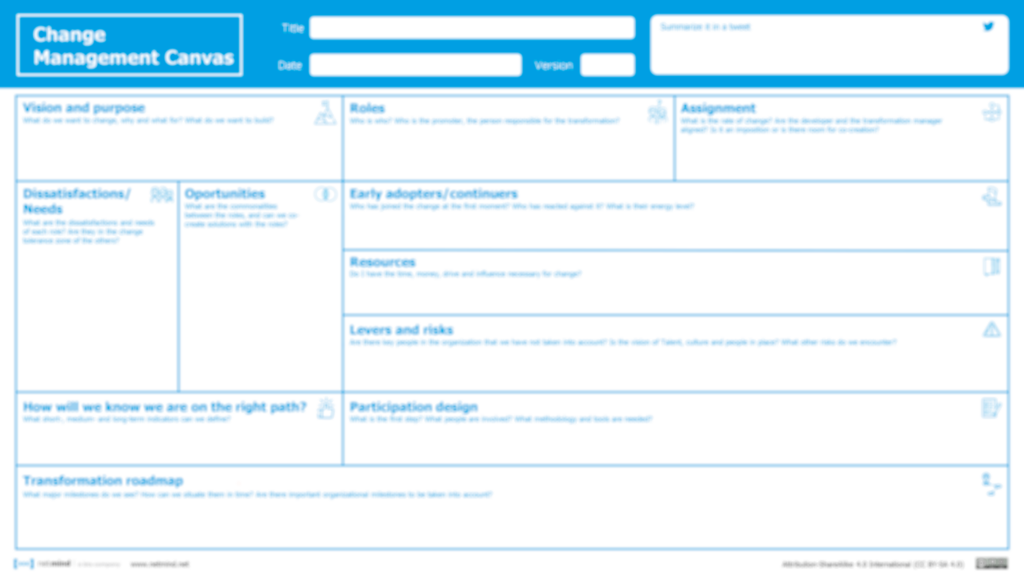7 questions to answer when facing a change management process-EN
Iria Rivero
- Change Management
- Article
Download complete infographic here!
Change agents must have a superpower: a great capacity for observation. They have to be able to see, listen and understand the context as if they were spectators in a play.
When you arrive in a new place, people may act differently because of your presence for a couple of days. After that, everything goes back to its usual dynamics. That’s when we can observe how people in the organization relate to each other: what motivates them, what makes them angry, what they need, and what worries them.
Empathy rules at the beginning of the journey in this process, understanding each person and leaving out our backpack of prejudices and preconceived ideas.
In this first stage of a change management process, it is essential to understand the different options for facilitating change. We must ask ourselves questions that help us to form a complete picture of the situation:


Why is the change being made?
This is always the first step in any issue: why and what for? We need to be aware of the purpose of change and, above all, make it understood by everyone. It is essential to test its strength in this first step.
Identifying roles: who is who?
We need to understand who decides to invest in the change and who is responsible for carrying it out within the organization. These two roles, promoter, and transformer are the decision makers. Without them on board, no change is possible.
The facilitator must know about people, organizational scenarios, processes, and options for participatory processes. They do not make decisions, but generate spaces, know tools and give options to the other roles so that they come to understand each other.
There is another role that does not occur in all contexts. They are the people who, without being promoters or responsible for the transformation, can be decisive in the success of the change process, such as senior managers or culture and talent departments. It is key to identify them as soon as possible to understand their needs and find a way to add their point of view to the process.
The last role is fundamental to completing the picture and is the impacted people. What type of stakeholders are they, and what level of participation will they have in the change management process, taking into account both internal and external people.
Although we are identifying it in a single role, it is full of different and complex realities, as many as the number of people, and it is something ant to take into account from the beginning.
These basic roles will be joined by others at a later stage.
What is the task?
We must try to put judgments aside and empathize with each role. First of all, we need to work with the promoter and the transformation manager. The objective is to guide them to think about all the possible aspects and impacts that the change management process may have.
Before initiating the process publicly, they should gather information on who the stakeholders are, what they want to achieve, what difficulties they will face, what support they have, and who should be part of the team driving the change.
In addition, it is necessary to take into account the expectations of how long they think this process should last. All of this will result in the strategy, which will then be made public.
What is each person’s tolerance zone?
Nothing is either black or white. There are many grays in between, and in that diversity of dissatisfactions and needs is where we must dive and find the opportunities, so we must understand the red lines of each role. The gap between what is non-negotiable and what we want has many nuances. Detecting and generating these first areas of agreement is the facilitator’s job.
What information do the first steps give us back?
When the purpose of the change is told to all those affected, it must be in an environment of trust, security, communication, and feedback.
When the first sessions begin, it is important to detect the energy level of the participants. It can range from reactivity to maximum involvement, both to join the change and position themselves in the continuity of what is already there.
Identifying the levels of participation and generating the dynamics around them is the facilitator’s job. In addition, they will encourage the roles to define indicators and make decisions based on the data.
To this end, the first hypotheses will be formulated and will validate whether the results are as expected or not, which helps us focus on the effect generated by the steps taken, looking beyond the actions we implement and focusing on what is important.
Who is an early adopter and who prefers continuity?
People in the organization always react to change; if they do not show it at first, it does not mean that it will not happen later.
Depending on their context, they will position themselves to be carried along by the majority, to be interested, to be ambassadors of change, or to position themselves in the forces for stability by opposing change.
For people who are closer to change it will be easier to find out what motivates them, for those who are in the continuity we will have to make an extra effort to understand their reality to be able to add their point of view. The rest of the grays between these two positions will join the change as the wave arrives, so it is important to focus the first efforts on early adopters to help spread the need for change.
What comes out of the change formula?
Here again, we appeal to the superpower of the observational change manager, who takes into account a systemic view of the organization.
One way of explaining how to analyze this balance of forces is with Richard Beckard‘s change process formula, which you can find in more detail in this article.
The idea of this formula is to take into account at each step of the process that the forces for change are greater than those for continuity and helps us to focus on what we are trying to achieve.
The usual scenario that we are going to encounter is going to have some reluctance, and that’s okay. It is part of the change process to understand that not all people will join without a second thought. Organizations are made up of people, with different realities, pressures, and values.
The balance of power must be in favor of the motivation for change, and knowing how to identify what is not working in the formula helps in trying to get them involved as soon as possible.
The eighth question could be: what now?
All these questions have helped us to define the Minimum Viable Change. The next steps will follow the scientific method: launch new hypotheses, select metrics, measure, and learn.
As the change progresses, so will the roles and actions, the biggest challenge being to read the external conditions and changes so that the organization can constantly adapt.
Change Management Process Canvas
Download the Change Management CANVAS to get an overview of the process before you start.






